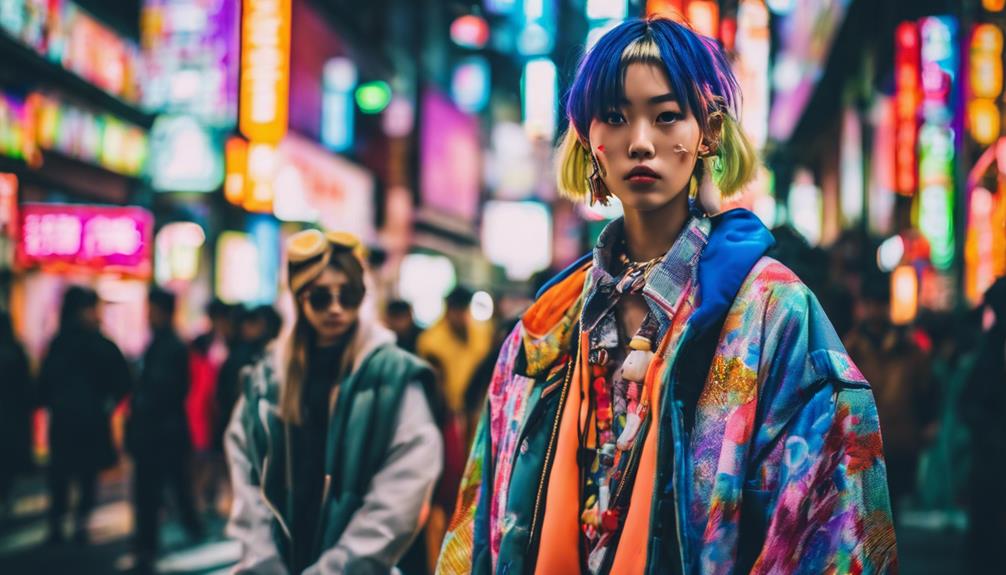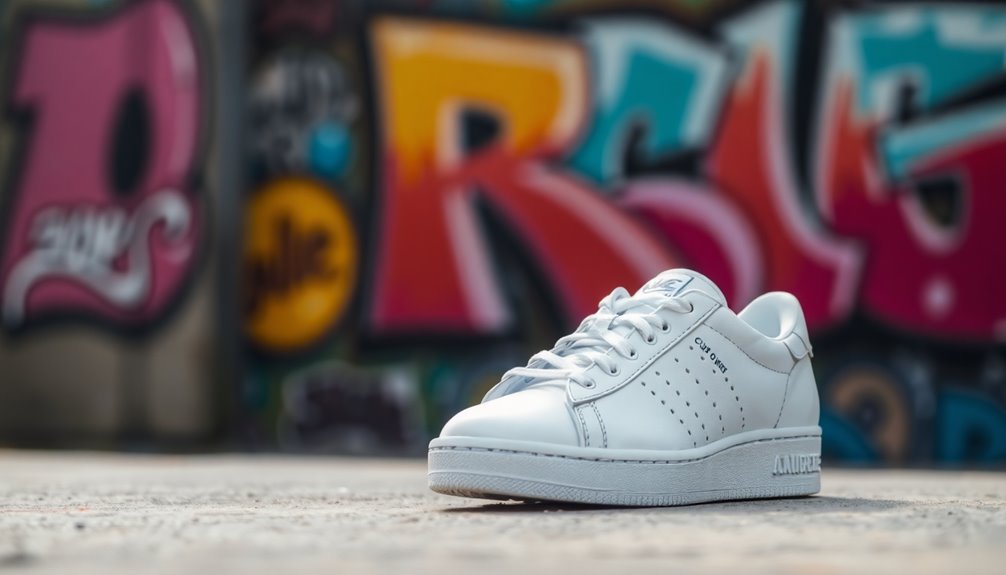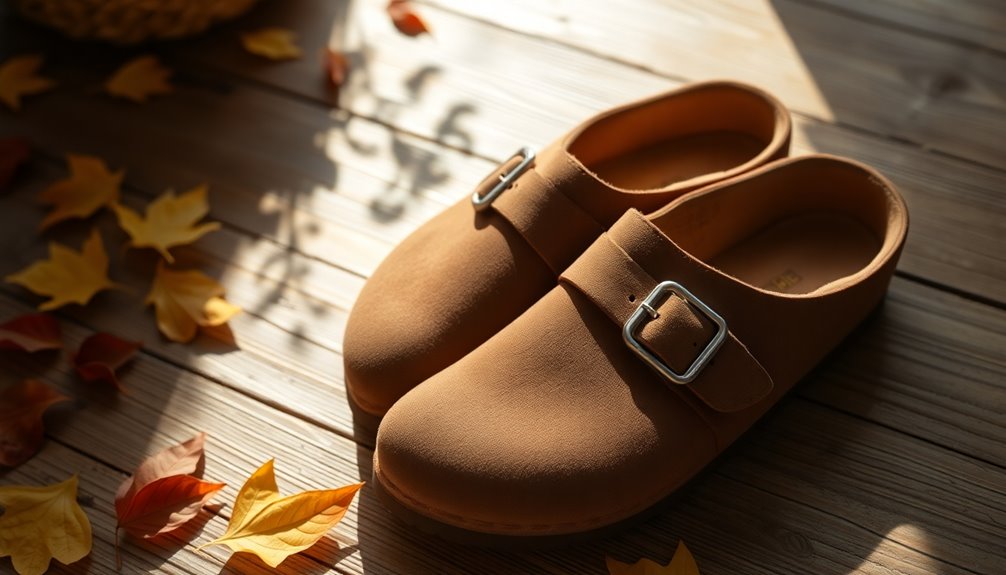Yes, Zara is without a doubt considered fast fashion. Since its establishment in 1975, the brand has perfected quick production cycles, unveiling around 500 new styles each week. Zara’s business model focuses on fashionable yet reasonably priced apparel, establishing its significance in the fast fashion industry. Nonetheless, this strategy gives rise to concerns about sustainability, as it heavily depends on synthetic materials and swift inventory turnover. Many shoppers are increasingly mindful of these issues and are on the lookout for eco-friendly alternatives. If you’re interested in learning more about Zara’s practices and the impact of fast fashion, there is a plethora of information to delve into on this subject.
Key Takeaways
- Yes, Zara is a leading example of fast fashion, producing high volumes of trendy clothing at affordable prices.
- The brand launches around 500 new styles weekly, ensuring it stays aligned with current fashion trends.
- Zara produces over 450 million garments annually, primarily using synthetic materials like polyester, raising sustainability concerns.
- The fast fashion model promotes overconsumption, leading to environmental scrutiny and calls for responsible consumption.
Origin and historical background of the fashion trend/style
You might notice that the shift from couture to casual wear has transformed the fashion landscape considerably.
As streetwear culture rises, it influences how you approach style and affordability.
This evolution sets the stage for understanding how brands like Zara fit into the fast fashion narrative.
Shift From Couture to Casual
The shift from couture to casual fashion emerged in response to changing lifestyles and an increasing demand for comfort, paving the way for brands like Zara to thrive in the fast fashion landscape. Founded in 1975, Zara revolutionized how we think about clothing by adopting a business model focused on quick turnarounds and high inventory turnover. This approach allows you to access trendy styles that blend high fashion with everyday wear.
As casual wear gained popularity in the 1990s and 2000s, Zara quickly adapted its offerings to meet consumer demand for comfortable, fashionable clothing. With around 500 new styles launched weekly, the brand capitalizes on current trends, ensuring you have the latest looks without breaking the bank. This strategy not only makes luxury-inspired styles available to the average shopper but also highlights Zara's commitment to affordable prices.
In this fast-paced environment, Zara's ability to respond swiftly to runway trends and consumer preferences solidifies its position as a leader in fast fashion, making it easier than ever for you to stay stylish while prioritizing comfort.
Rise of Streetwear Culture
Emerging alongside the rise of casual fashion, streetwear culture began to take shape in the late 1970s and early 1980s, drawing inspiration from the skate and hip-hop communities in urban centers like New York and Los Angeles.
This movement merged comfort and style, emphasizing casual wear that featured graphic tees, hoodies, and sneakers. By the 1990s, brands like Stüssy and Supreme solidified streetwear's presence in mainstream fashion, blending everyday clothing with high-end aesthetics.
The culture thrives on exclusivity, often marked by limited edition drops and collaborations that create immense consumer demand. You might've noticed how some streetwear items have fetched exorbitant resale prices, making them highly sought after.
Social media and influencer marketing have played pivotal roles in this evolution, amplifying brand visibility and transforming streetwear into a global phenomenon.
Today, streetwear culture isn't just a fashion trend; it's a lifestyle that reflects individuality and social status. As you explore this vibrant world, you'll see how it continues to reshape the fashion landscape, making a lasting impact on how you view style today.
Key Characteristics
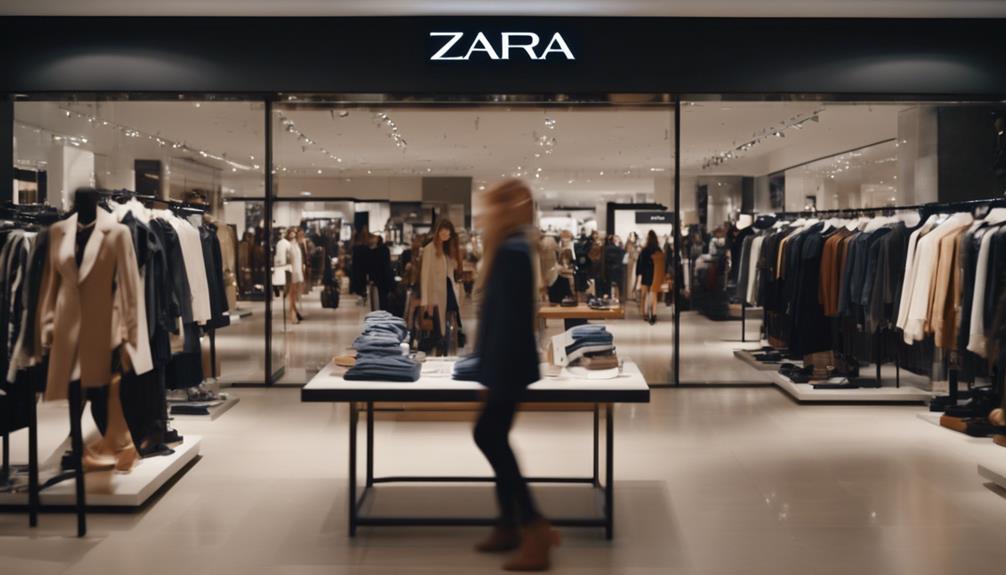
When you think about Zara, you can't ignore its trendy yet affordable styles that attract countless shoppers.
The brand often uses synthetic fabrics and bold hues to create eye-catching pieces, including statement tees and bags that make a strong impression.
Let's explore these key characteristics that define Zara's fast fashion model.
Trendy yet Affordable Styles
Zara's blend of trendy designs and affordable prices makes fashion accessible for everyone. With its fast fashion model, the brand brings new styles from concept to store in as little as 15 days. This rapid inventory turnover means you can find fresh, fashionable wardrobe options each time you visit. Zara introduces around 500 new styles weekly, guaranteeing that its offerings are always in line with current trends.
The appeal of Zara lies in its ability to replicate runway-inspired styles at accessible price points. Rather than breaking the bank for high-end fashion, you can enjoy trendy designs that fit your budget. This strategy attracts a diverse consumer base, from fashion enthusiasts to everyday shoppers, all seeking chic and affordable clothing.
Zara's commitment to affordable pricing without sacrificing style has solidified its position as a go-to for anyone looking to elevate their wardrobe. Whether you're shopping for a casual outfit or something more sophisticated, Zara's vast selection of fashionable wardrobe options guarantees you'll find something that suits your taste and budget.
With each visit, you can expect to discover new styles that keep you on-trend without overspending.
Synthetic Fabrics and Bold Hues
Synthetic fabrics and bold hues define Zara's collections, making fashion both eye-catching and accessible. The brand mainly uses synthetic materials like polyester and nylon, which account for a massive portion of its 450 million garments produced annually. With over 500 new styles launched weekly, Zara keeps its offerings fresh and closely aligned with high-end fashion trends, often featuring vibrant, bold hues that catch your eye.
However, the reliance on synthetic fabrics raises significant environmental concerns. Since these materials are non-biodegradable, they contribute to the growing issue of microplastics in our oceans, which now accounts for one-third of ocean microplastics. This fast fashion model encourages overconsumption, as the quick turnaround from design to retail—approximately 15 days—makes it easy to buy more than you need.
While Zara's approach makes trendy fashion accessible, it's crucial to weigh the allure of bold colors and rapid releases against the long-term impact on the environment. Being aware of these issues can help you make more informed choices in your shopping habits, balancing style with sustainability.
Statement Tees and Statement Bags
How do statement tees and bags capture the essence of fast fashion while reflecting the latest trends and social issues?
Zara expertly combines bold designs and affordability in their statement tees and bags, making them highly sought after in the trendy fashion world. With prices ranging from $15 to $50, you're tempted to buy multiple pieces, contributing to the cycle of overconsumption.
These statement items often feature eye-catching slogans or graphics, allowing you to express your style and opinions. However, the rapid production of these tees and bags raises concerns about sustainability and the environmental impact of fast fashion.
Zara's model prioritizes speed, introducing new styles multiple times a week, which often leads to questionable quality and ethical production practices.
While these statement pieces fulfill your desire for trendy fashion, they also highlight the broader issues within the fast fashion industry. As you enjoy the affordability and style of Zara's offerings, consider the implications of your purchases on both the environment and your wardrobe.
Balancing personal expression with sustainable choices is essential in today's fashion landscape.
Modern Interpretation
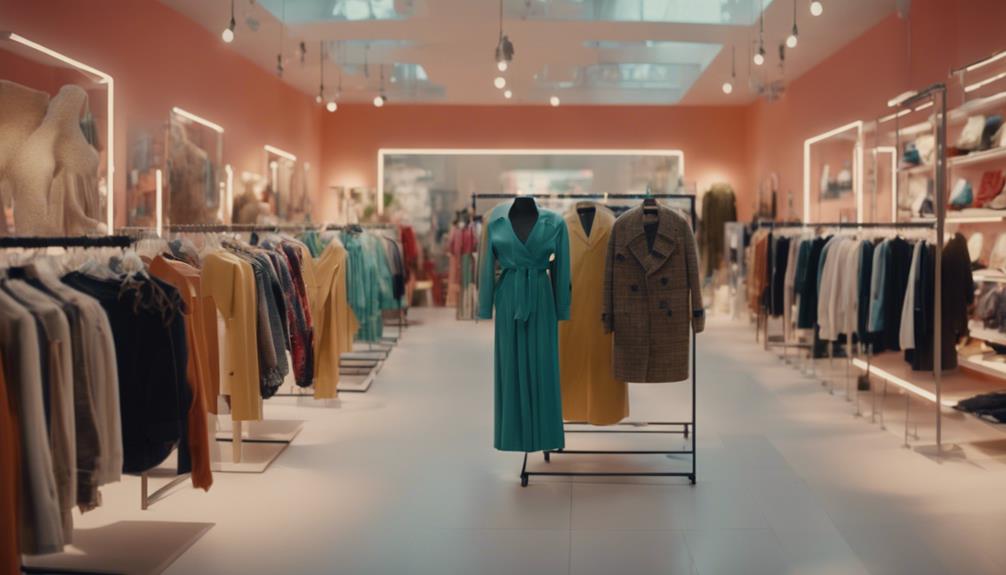
As you explore the modern fashion landscape, you'll notice a shift towards sustainability that's challenging the fast fashion model.
Emerging sustainable fashion labels and fashion-forward social media influencers are reshaping consumer expectations and pushing for more responsible practices.
This movement raises important questions about how brands like Zara fit into the evolving narrative of fashion today.
Sustainable Fashion Movement
The sustainable fashion movement actively challenges the harmful practices of fast fashion by promoting eco-friendly materials and ethical labor conditions. This movement seeks to address significant ethical issues and the environmental impact of the fashion industry, advocating for practices that emphasize waste reduction and transparency. Brands like Tentree and People Tree are at the forefront, showcasing commitment by planting trees for purchases and ensuring fair trade in their supply chains.
As consumer awareness grows, many are turning to sustainable fashion alternatives, such as second-hand shopping, clothing rentals, and upcycling initiatives. The Ellen MacArthur Foundation champions a circular economy in textiles, encouraging design strategies that minimize waste and extend clothing lifecycles through recycling and repair.
However, the fashion industry still faces challenges, as over 60% of sustainability claims are unsubstantiated, highlighting the need for greater accountability. You can support this movement by choosing brands that prioritize sustainability and transparency. By making informed choices, you contribute to a shift away from fast fashion, fostering an industry that respects both the planet and the people who produce our clothes.
Emerging Sustainable Fashion Labels
Emerging sustainable fashion labels are reshaping the industry by offering eco-friendly alternatives that prioritize ethical practices and transparency over fast fashion's harmful impacts. Brands like Tentree and Toad & Co are leading the charge, focusing on sustainable materials and responsible production methods.
Tentree plants a tree for every purchase, while Toad & Co has committed to planting over 61 million trees, showcasing their dedication to reducing environmental impact.
You'll find that these emerging labels emphasize transparency in their supply chains. Kotn, for example, uses BCI-certified Egyptian cotton and actively combats child labor, ensuring that their practices align with consumer demand for ethical options.
As consumers increasingly seek alternatives to traditional fast fashion retailers like Zara, these brands fulfill a growing desire for quality and durability over disposable trends. With price ranges that cater to different budgets, from $12 to $475, sustainable fashion isn't just a niche market anymore.
It's becoming mainstream. By supporting these eco-friendly labels, you contribute to a movement that values ethics and sustainability, ultimately driving the fashion industry toward a more responsible future.
Fashion-Forward Social Media Influencers
Fashion-forward social media influencers are reshaping the way you perceive and engage with Zara's ever-evolving collections. By showcasing Zara's latest releases, they're creating trendy looks that resonate with your desire for stylish outfits at an affordable price. Influencers take advantage of Zara's rapid turnover of styles, aligning perfectly with the fast-paced nature of social media, which keeps their content fresh and engaging.
These influencers highlight how Zara replicates high-end fashion trends quickly, boosting the brand's reputation among fast fashion brands. Their endorsements spark consumer demand, making Zara a go-to choice for fashion enthusiasts who want to stay on-trend without overspending.
However, this rising visibility also comes with scrutiny regarding Zara's sustainability practices. As influencers promote the brand, they inadvertently shape public perception, which can lead to increased awareness of the environmental impact of fast fashion.
Ultimately, social media influencers play a vital role in connecting you with Zara's collections, driving a mix of excitement and critical conversation around affordability, trendiness, and sustainability in the fashion industry. Their influence is undeniable, making Zara a staple in modern fashion discussions.
Styling Tips

When it comes to styling with Zara, you can effortlessly elevate your wardrobe by focusing on timeless staples that never go out of fashion.
Experiment with seasonal layering techniques to create chic looks for any occasion, and don't shy away from combining patterns and textures to express your unique style.
With these tips, you'll maximize your Zara pieces and keep your outfits fresh and exciting.
Timeless Wardrobe Staples
Timeless wardrobe staples are essential pieces that can effortlessly elevate your style and adapt to any occasion.
Investing in a tailored blazer is a smart choice; it's a classic item that seamlessly shifts from casual outings to formal events. Pair it with a high-quality white button-up shirt, which is versatile and can be styled for work or weekend plans, ensuring you always look polished.
A well-fitting pair of jeans is another must-have in your wardrobe. They provide endless styling options—dress them up with heels for a night out or keep it casual with sneakers.
The little black dress (LBD) is your go-to piece for any event; it's easily accessorized, making it an essential item for a chic look.
Don't forget classic footwear, too. Timeless ankle boots or sleek loafers can enhance any outfit while providing comfort throughout the seasons.
Seasonal Layering Techniques
Mastering seasonal layering techniques allows you to create stylish outfits that adapt to changing temperatures while keeping you comfortable.
Start with breathable fabrics for your base layer, like a fitted turtleneck or long-sleeve shirt. These lightweight tops provide the perfect foundation for layering.
Next, add a cardigan or a lightweight jacket to enhance warmth without sacrificing style.
To elevate your versatility, consider incorporating heavier materials as your outer layer. This combination not only helps with temperature regulation but also adds depth to your outfit.
Don't forget about accessories! Scarves, vests, and hats not only serve a functional purpose by offering extra insulation but also allow for creative expression.
Combining Patterns and Textures
Combining patterns and textures can transform your outfit into a visually striking ensemble, allowing you to express your unique style effortlessly. Zara offers a fantastic selection of affordable pieces that make it easy to experiment with different prints and fabrics. When you mix patterns, aim for a cohesive color palette; Zara's collections often feature complementary colors, simplifying the pairing process.
Incorporating textured fabrics like knitwear or denim adds depth to your outfit. Look for ribbed sweaters or structured blazers at Zara, as they blend beautifully with softer patterns. Accessories can also be essential in this mix; chic scarves or bags from Zara can tie together various textures without overwhelming your look.
Don't shy away from bold prints; they can create a stylish contrast when balanced with understated items. Zara's seasonal collections frequently highlight statement pieces that can elevate your ensemble.
Shopping Guide

When shopping at Zara, you'll find a constantly changing selection that keeps you on your toes with new styles arriving twice a week. This fast fashion model means you can enjoy affordable luxury, but it also encourages rapid inventory turnover, leading to frequent shopping trips.
As you browse, consider the environmental impact of your choices; Zara's sustainability initiatives aim for 100% sustainable materials by 2025, yet their actual progress and transparency have faced criticism.
While Zara offers trendy pieces at appealing prices, consumer awareness of the implications of fast fashion is increasing. Many shoppers are now seeking ethical alternatives, questioning labor practices and the sustainability of the garments they purchase.
Before making a decision, weigh the benefits of that chic sweater against the broader impact of your wardrobe.
Upcycled Fashion Projects
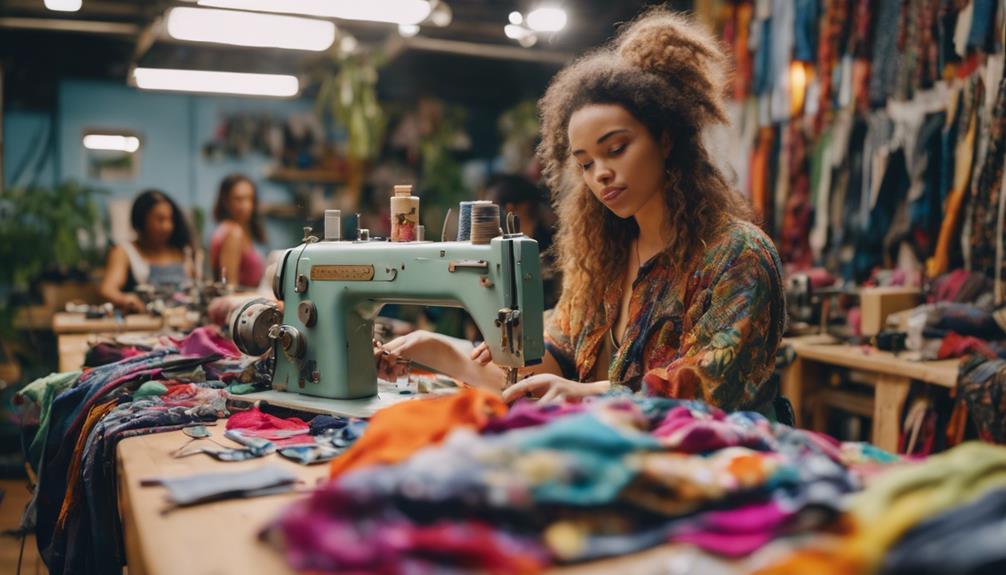
Upcycling old clothing is a creative way to breathe new life into items that might otherwise end up in the landfill.
You can use techniques like patchwork or dyeing to personalize your wardrobe, making each piece truly unique.
Let's explore how you can transform discarded garments into fashionable statements while embracing sustainability.
Repurposing Old Clothing Techniques
Transforming old clothing into stylish, one-of-a-kind pieces not only sparks creativity but also plays an essential role in reducing textile waste.
Upcycled fashion allows you to give new life to garments you might otherwise discard, promoting sustainability in your wardrobe. By repurposing textiles, you can create unique items that reflect your personal style, all while minimizing your environmental footprint.
Engaging in creative DIY projects can save you money and inspire innovation. You might turn an old pair of jeans into a trendy bag or transform a vintage dress into a chic top.
Brands like Reformation and Patagonia lead the charge in upcycled fashion, showcasing collections made from recycled materials and encouraging others to follow suit.
The increasing popularity of second-hand shopping and clothing rental services highlights a growing awareness of the importance of sustainability. By choosing these options, you not only reduce textile waste but also contribute to a more circular fashion economy.
Embrace upcycled fashion and discover how repurposing old clothing can make a meaningful impact on both your style and the planet.
Personalized Clothing Embellishment Ideas
Personalized clothing embellishments can turn your basic garments into standout pieces that showcase your unique style and creativity. Techniques like embroidery, fabric painting, and appliqué allow you to transform old clothes or fabric scraps into something special. By upcycling, you greatly reduce textile waste, which is essential as millions of tons of clothing end up in landfills each year.
Engaging in DIY projects not only saves money but also aligns with the growing trend toward sustainable and ethical fashion. You can source materials from thrift stores or your own wardrobe, making these projects both budget-friendly and environmentally conscious. Adding patches, beads, or even hand-painted designs can breathe new life into fast fashion items, extending their lifespan and promoting a more sustainable approach to clothing.
Participating in personalized clothing projects fosters creativity and empowers you to contribute to the circular fashion movement. By embracing this hands-on approach, you help shift away from overconsumption and the fast fashion model. So, get creative and start embellishing your wardrobe today! Your unique touch can make a considerable difference in the world of fashion.
Cultural Impact
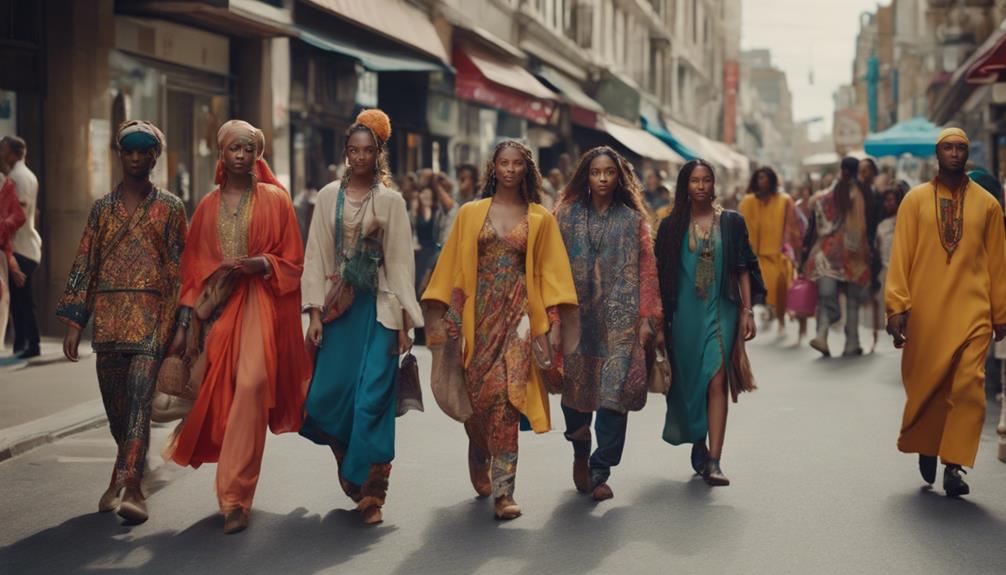
Zara's influence stretches beyond retail, shaping cultural moments in music videos and sparking fashion activism.
When you see your favorite artists rocking Zara pieces, it blurs the lines between high fashion and everyday wear.
This impact raises awareness about fashion's role in society, urging you to think about what you wear and why it matters.
Fashion in Music Videos
Fashion in music videos plays a pivotal role in shaping cultural trends, as artists frequently showcase Zara's trendy pieces, making them highly desirable to their fans.
When you watch your favorite music videos, you can't help but notice how often Zara clothing is featured. This visibility not only enhances the brand's image but also reinforces the fast fashion model, allowing Zara to quickly adapt runway trends for mass consumption.
As you see your favorite artists rocking distinctive Zara outfits, a sense of aspirational lifestyle emerges. This connection encourages you to emulate their styles, driving consumer demand for the brand.
High-profile collaborations between Zara and musicians create buzz, making the brand synonymous with current trends and popular culture.
In the world of music videos, Zara's presence is a powerful indication of how fashion influences culture. The brand's ability to resonate with younger audiences through visual storytelling enables it to remain relevant and desirable.
Fashion Activism and Awareness
As you explore the influence of fashion in music videos, it's important to recognize the growing movement of fashion activism that's reshaping how consumers view brands like Zara.
Increasingly, consumers are scrutinizing the fast fashion industry for its harsh labor practices and environmental impact. Activists are calling for greater transparency and ethical practices, pushing brands to own up to their sustainability claims.
The devastating Rana Plaza disaster in 2013 sparked significant outrage, highlighting the need for systemic changes in labor rights within the fast fashion industry, including Zara. This pivotal moment ignited consumer-led movements advocating for slow fashion and sustainable alternatives.
Social media has become a powerful platform for these activists, raising awareness about the negative impacts of fast fashion, which contributes to one-third of ocean microplastics and 20% of global water waste.
As a result, brands like Zara are feeling the pressure to adapt their marketing strategies and sustainability initiatives. This cultural shift encourages you to reflect on the ethical implications of your fashion choices and supports a more mindful approach to consumption.
Frequently Asked Questions
Does Zara Treat Their Workers Well?
You might find that Zara's treatment of workers raises serious concerns. Reports of poor labor practices, wage theft, and lack of transparency suggest that workers often face challenging conditions, contradicting the company's stated commitment to ethical practices.
What Is the Copycat Controversy With Zara?
Zara's copycat controversy stems from accusations of design theft, where independent creators claim the brand replicates their work without credit. This pattern raises ethical concerns about intellectual property and the treatment of artists in fashion.
Is Zara a Trusted Brand?
You might question Zara's trustworthiness due to ongoing labor and environmental concerns. With allegations of unsafe working conditions and questionable sustainability practices, it is crucial to research thoroughly before deciding if you can trust the brand.
What Is Zara's Sustainability Dilemma?
Zara's sustainability dilemma lies in its rapid production and high garment turnover, which fuels overconsumption. Despite ambitious goals, skepticism surrounds their claims, with many efforts viewed as unsubstantiated and sometimes labeled as greenwashing by critics.
What Makes Zara a Fast Fashion Brand and How Does It Compare to Patagonia’s Sustainable Fashion Practices?
Zara’s rapid production and quick turnaround make it a prime example of fast fashion, while Patagonia’s sustainable fashion practices set it apart with its focus on quality, ethical sourcing, and environmental responsibility. The contrast between Zara’s fast-paced approach and Patagonia’s commitment to patagonia sustainable fashion choice highlights the diverse strategies in the fashion industry.
Conclusion
To sum up, Zara embodies the essence of fast fashion with its rapid production and trend-driven designs.
By understanding its origins and characteristics, you can make more informed choices about your wardrobe.
Remember to mix high and low pieces, and consider upcycled fashion projects to reduce your environmental impact.
Ultimately, being mindful of your shopping habits can help you enjoy stylish clothing while supporting a more sustainable future in fashion.


